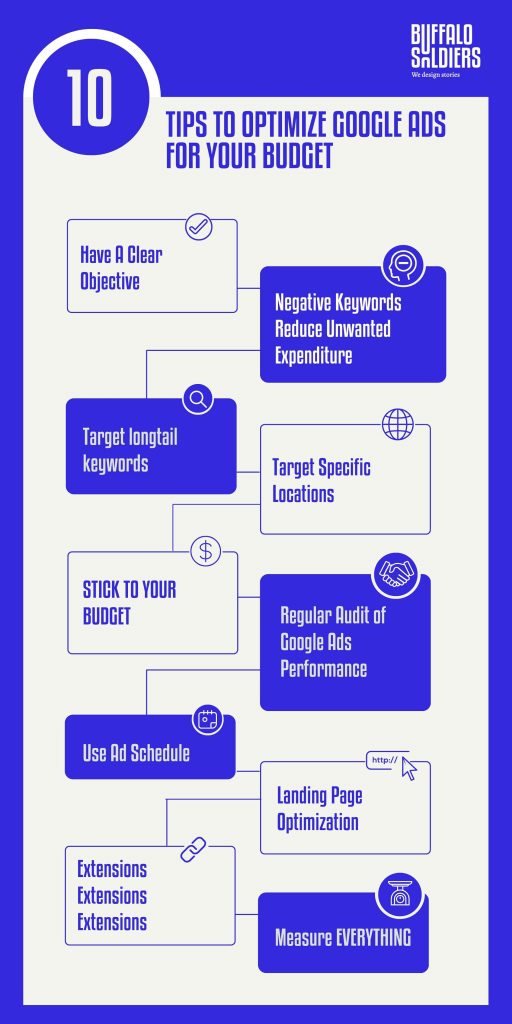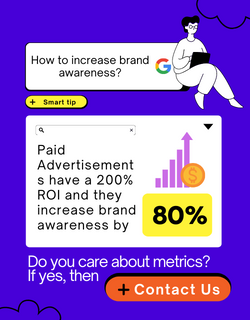It doesn’t matter if you’re new to Google Ads or a seasoned veteran, the end goal for everyone is to maximize our budget. Setting up accounts and ad campaigns properly takes higher precedence now than ever.
Businessowners nowadays don’t just go online – THEY LIVE ONLINE. We reach for the nearest device the moment we want to know, buy or sell something. Are we really becoming cyborgs? Are mobile phones truly becoming an extended part of our human civilization? (Calm down Apoorva, this is not the time to dig deep into the Rabbit Hole).
It’s time to try new online marketing strategies and plan campaigns based on data from Google Ads management services. Keep making changes until your advertising meets your business goals.
Deploy the use of Smart Campaigns – Google’s smart and simple solution for small businesses, helping your business get found on Google in the moments that matter.
Now, how does one do that? What are these data-driven result-oriented campaigns that we are talking about? The answer is simple: A Boffin’s Nirvana.
Enough digressing – let’s get back to the point. We want to help you set up ad campaigns in such a way that you get the maximum reach possible for the budget that you have. Optimization is the name of the game, and here’s how you should implement these strategies if you’re looking to make a name for yourself in this harsh competitive world.
10 Tips To Optimize Google Ads For Your Budget
Prepare yourself – a bladestorm of information is coming your way.

1. Have A Clear Objective
You need to have the bigger picture at the forefront of your thought process before starting any campaign. Keep these things in mind:
- What are my advertising goals?
- What are my overall business goals?
- How do I get specific with my conversion goals?
You can then precisely target specific keywords to reach the desired audience with a maximum budget to ensure you never overdo it. Late on, you can explore bid strategies such as CPA, cost-per-acquisition or CPM, and cost-per-1000 impressions once you become a skilled advertiser.
2. Negative Keywords Reduce Unwanted Expenditure
Unfortunately, negative keywords are applied reactively far too many times than proactively. Brands spend money needlessly on terms such as phone numbers, customer care services, or reviews. What’s worse is that they could end up spending money on unrelated or inappropriate phrases as well!
Two categories of negative keywords you can apply:
- General Negative:
- Adult Terms
- Litigious Terms
- Quality Terms
- Brand Negatives:
- Owned Property Indicators
- Brand Research Terms
- Employment Terms
3. Target longtail keywords
Consider trying some “long-tail keywords,” or longer keyword phrases of three or more words. Because they’re less obvious or prevalent, there’s less competition for these keywords, which means they also tend to have a lower average cost per click. Nevertheless, they are also more targeted, which means they can attract people who are more likely to buy, call, or visit your business.

4. Target Specific Locations
If you have a local business and want to drive more customers, showing your ads nationwide could consume a chunk of your budget without getting you closer to your goal.
Change your Google Ads targeting settings to show your ads only to people close enough to visit or in other places important to your business so that your budget gets used more effectively. Keep an eye on your Google Ads management services to see which geographic areas your traffic and conversions are coming from.
5. STICK TO YOUR BUDGET
Set your monthly Google Ads marketing budget and stick to it for a while. Google Ads allows you to set a daily limit on how much of your budget gets spent running your ad, and sometimes your daily budget may seem higher.
Google analyzes daily search traffic and will show your ads more frequently on days when more people are searching and less when traffic is low. It means your daily budget can fluctuate by as much as 20%. Avoid tinkering with your budget limits too much – allow time for the results to appear before making further adjustments to your campaign.
6. Regular Audit of Google Ads Performance
Your team needs to monitor and optimize performance on a weekly, if not daily basis. It takes a lot of time as you need a lot more data, and overall it should result in more strategic changes to your account.
A quarterly review of advertising accounts is generally the right approach, but you should set aside time to review them at least twice a year and whenever you plan a strategy update. A comprehensive audit should focus on audience performance by asset performance (ad type, images, landing pages), cohort (device, location, etc.), poor performers (keywords, placements, etc.), and competitor analysis and tactics.
7. Use Ad Schedule
Google publishes ads every hour of every day of the week. There is a likelihood that you won’t be generating as many sales or leads at 4 AM as you were at 4 PM. Implementing ad hours allows you to tell Google what time and days you want your ads to run. Also, once these ad programs are good to go, you can add bid adjustments to further optimize your spending on them.
8. Landing Page Optimization
The goal here isn’t just to create an ad that someone clicks. It’s supposed to create an ad that someone clicks on to find the product or information they were looking for.
A bait and switch tactic is a BIG NO NO, as it not only affects your sales but also your Google Ad Quality Score, causing you to drop in the rankings. Let’s be authentic, and optimize your landing page for conversions by making targeted offers you can follow.
9. Extensions Extensions Extensions
Ad extensions are a proven way to boost the click-through rate of your search ads, which in turn should enhance the effectiveness of your budget. But they are also beneficial from a supply perspective.
The more extensions you run with an ad, the more of your message your audience will see, which can help increase recall and demand even when the user doesn’t click on your ad. Sometimes maximizing your budget isn’t about getting the cheapest clicks it’s about spending the most wisely.
10. Measure EVERYTHING
One of the most prominent advantages of Google Ads Management Services is that you can track the results of your online marketing campaigns and adjust your strategies and budget at any time. That way you can test what works and make the required adjustments. Continuously test new strategies and campaigns, guided by data procured from Google Ads and Analytics, until you find the advertising formula that helps you achieve your business goals.
And Therefore…
Who doesn’t like stats and numbers? Let’s take a look at one that will blow you away. A study has shown that digital advertisers spending worldwide amounts to $521 Billion!
In fact, giant retailers can spend upwards of $50 million a year on Google Ads. Those are astronomical figures, and it would be egregious for anyone to assume to spurge that amount of money. The beauty of Google Ads is that it incorporates your budget to your business goals.
Still, if there are issues regarding how one implements this structure in their business – do not sweat it. We have got you covered.
We are Buffalo Soldiers, a performance marketing agency in India. Our team of professionals live, breathe and sleep Google Analytics and data. With a stellar track record, we have proven our mettle in performance marketing and adjusting campaigns to accommodate the client’s budget.
Reach out to us – we offer free consultation and help you curate a marketing plan for your business.


